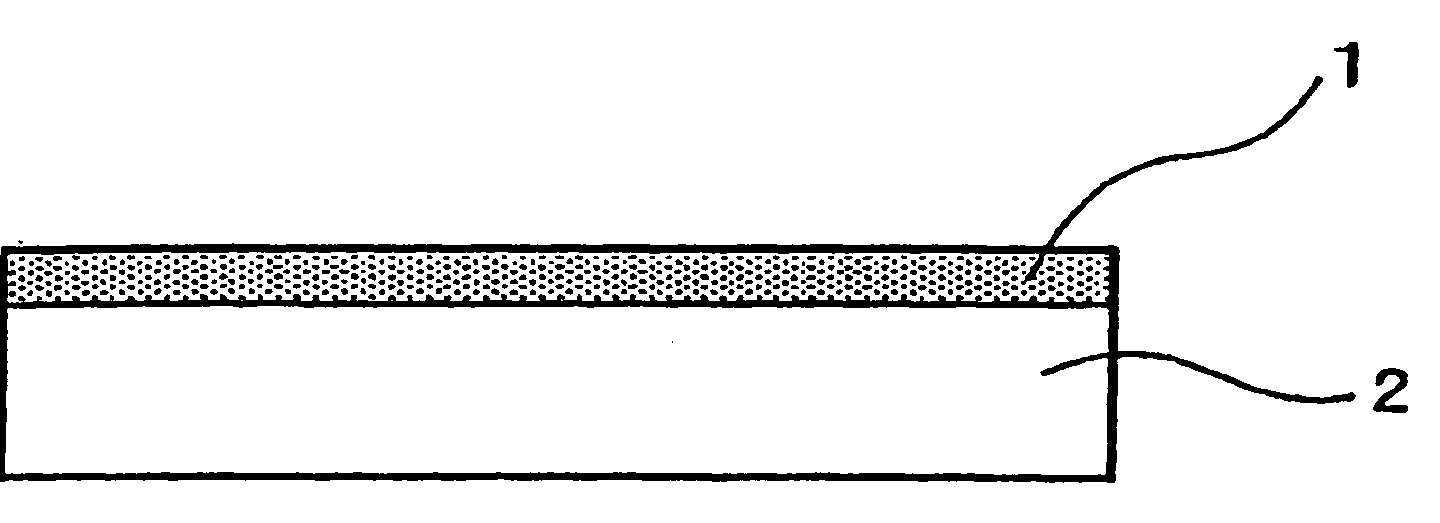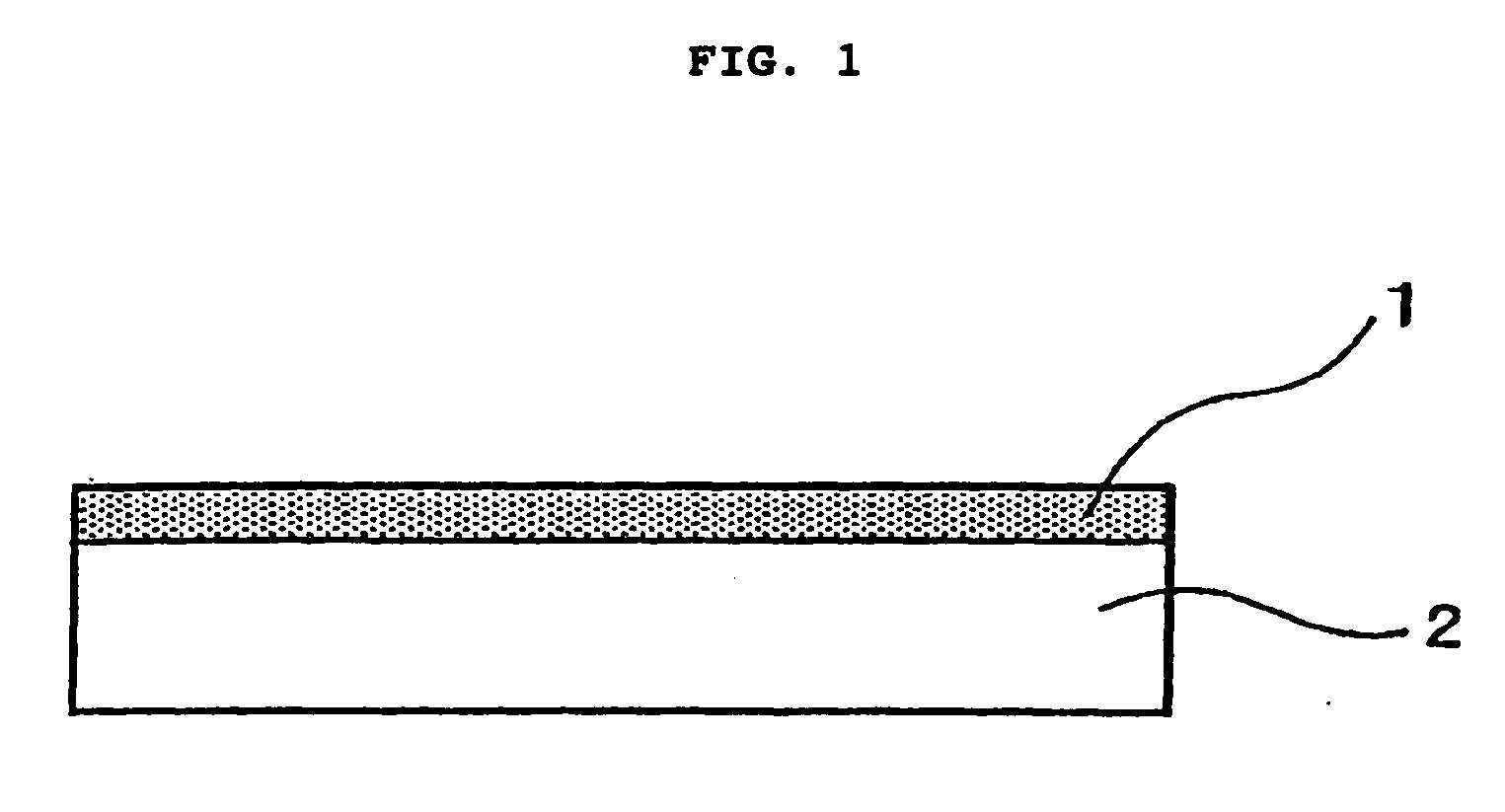Diamond-coated electrode and method for producing same
- Summary
- Abstract
- Description
- Claims
- Application Information
AI Technical Summary
Benefits of technology
Problems solved by technology
Method used
Image
Examples
example 1
[0070] Substrates of the size and material shown in Table 1 were used as a base material, and the surface thereof was scratched with diamond powder and then washed. Each of these substrates was placed in the synthesis apparatus shown in Table 1, and conductive diamond 1 was synthesized on the base material 2 as shown in FIG. 1.
[0071] As shown in Table 1-1, the synthesis was conducted at a gas pressure of 2.7 kPa or 7 kPa, a hydrogen flow of 5000 sccm, and a methane (CH4) flow range of 0.5 to 2.0 sccm. Triethyl borate [B(OC2O5)3] was used as a boron source. Argon gas was bubbled in as a carrier gas, and boron was supplied at a concentration range of 0.2 to 1.0% in atomic ratio with respect to carbon. The temperature of the substrate that is a base material was between 700 and 1000° C.
[0072] When the synthesis apparatus was a hot filament CVD apparatus (HFCVD), the filament was made of tungsten and the filament temperature was between 2000 and 2200° C. When the synthesis apparatus w...
example 2
[0079] Substrates of the various types and in the states of working shown in Table 2-1 were subjected to seeding with diamond powder in advance, after which a hot filament CVD apparatus was used to form a diamond film on each under several varieties of formation conditions (sample Nos. 2-1 to 2-20). The size of each substrate was 60 mm square, and the thickness was 2 mm. The coefficient of thermal expansion of each substrate was the average coefficient of thermal expansion within 40-800° C. The gases used here were introduced into the apparatus by bubbling argon through a bubbler, which was filled with H2, CH4 and trimethyl borate [B(OC2O5)3] as a boron source.
[0080] The common conditions were kinds of gases, an H2 flow of 1000 sccm, a CH4 flow of 20 sccm, and an Ar+B(OCH3)3 flow of 5 sccm, the use of a tungsten filament with a diameter of 0.2 mm, a filament temperature of 2200° C., and a substrate-filament spacing of 5 mm. The substrate temperature was adjusted to within 600-950° ...
example 3
[0088] Another experiment was conducted by using the substrates in Example 2 (sample Nos. 2-11, 12, 14, 16, and 17) and changing the conditions of the electrolysis test. The electrolysis test was conducted under the conditions: for 1000 hours using a 0.1M sodium sulfuric acid solution, at an electric current density of 1.0 A / cm2, and using the same type of electrode for both electrodes. The results are given in Table 3.
[0089] It can be seen from Table 3 that, with sample Nos. 2-12′ and 2-17′, which had the surface of a ceramic substrate worked after sintering, separation occurred in Example 3 that set the harsher conditions although no separation occurred in the electrolysis test of Example 2.
[0090] In contrast, no separation occurred in Nos. 2-11′, 2-14′ and 2-16′, which had the surfaces worked prior to sintering, even in the electrolysis test of Example 3.
[0091] Also, when the same substrate as 2-17′, which separated under the Example 3's conditions, was used and when the subst...
PUM
| Property | Measurement | Unit |
|---|---|---|
| Temperature | aaaaa | aaaaa |
| Temperature | aaaaa | aaaaa |
| Fraction | aaaaa | aaaaa |
Abstract
Description
Claims
Application Information
 Login to View More
Login to View More - R&D
- Intellectual Property
- Life Sciences
- Materials
- Tech Scout
- Unparalleled Data Quality
- Higher Quality Content
- 60% Fewer Hallucinations
Browse by: Latest US Patents, China's latest patents, Technical Efficacy Thesaurus, Application Domain, Technology Topic, Popular Technical Reports.
© 2025 PatSnap. All rights reserved.Legal|Privacy policy|Modern Slavery Act Transparency Statement|Sitemap|About US| Contact US: help@patsnap.com



